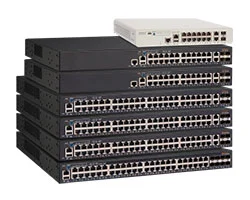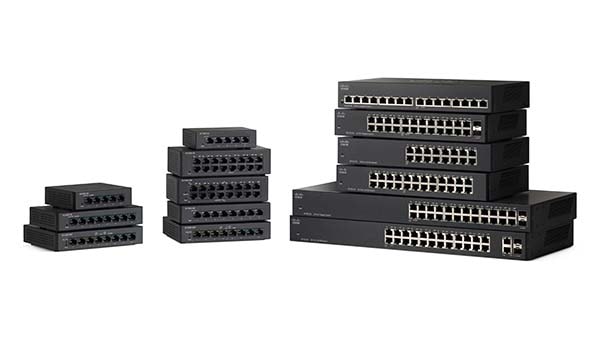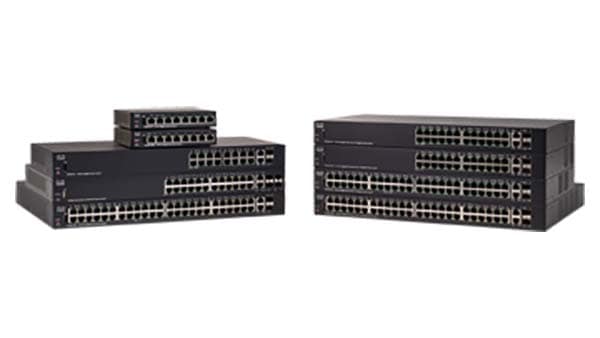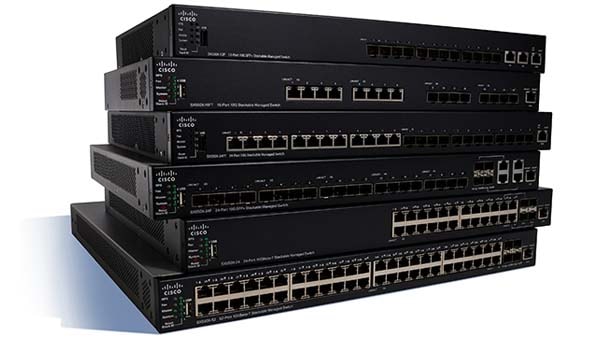Network Switches

Network Switches
Buy network switches from the industry leading network switch technology companies. Improve your network with top tier brands that include Fortinet, Cisco Meraki, Dell, and Ruckus Wireless. Upgrade your business network today with the right network switches from Firewall Firm
A network switch (also called switching hub, bridging hub, officially MAC bridge) is networking hardware that connects devices on a computer network by using packet switching to receive and forward data to the destination device.
A network switch is a multiport network bridge that uses MAC addresses to forward data at the data link layer (layer 2) of the OSI model. Some switches can also forward data at the network layer (layer 3) by additionally incorporating routing functionality. Such switches are commonly known as layer-3 switches or multilayer switches.
Switches for Ethernet are the most common form of network switch. The first Ethernet switch was introduced by Kalpana in 1990. Switches also exist for other types of networks including Fibre Channel, Asynchronous Transfer Mode, and InfiniBand.
Unlike less advanced repeater hubs, which broadcast the same data out of each of its ports and let the devices decide what data they need, a network switch forwards data only to the devices that need to receive it.
A switch is a device in a computer network that connects other devices together. Multiple data cables are plugged into a switch to enable communication between different networked devices. Switches manage the flow of data across a network by transmitting a received network packet only to the one or more devices for which the packet is intended. Each networked device connected to a switch can be identified by its network address, allowing the switch to direct the flow of traffic maximizing the security and efficiency of the network.
A switch is more intelligent than an Ethernet hub, which simply retransmits packets out of every port of the hub except the port on which the packet was received, unable to distinguish different recipients, and achieving an overall lower network efficiency.
An Ethernet switch operates at the data link layer (layer 2) of the OSI model to create a separate collision domain for each switch port. Each device connected to a switch port can transfer data to any of the other ports at any time and the transmissions will not interfere.[a] Because broadcasts are still being forwarded to all connected devices by the switch, the newly formed network segment continues to be a broadcast domain. Switches may also operate at higher layers of the OSI model, including the network layer and above. A device that also operates at these higher layers is known as a multilayer switch.
Segmentation involves the use of a switch to split a larger collision domain into smaller ones in order to reduce collision probability and to improve overall network throughput. In the extreme case (i.e. micro-segmentation), each device is located on a dedicated switch port. In contrast to an Ethernet hub, there is a separate collision domain on each of the switch ports. This allows computers to have dedicated bandwidth on point-to-point connections to the network and also to run in full-duplex mode. Full-duplex mode has only one transmitter and one receiver per collision domain, making collisions impossible.
The network switch plays an integral role in most modern Ethernet local area networks (LANs). Mid-to-large sized LANs contain a number of linked managed switches. Small office/home office (SOHO) applications typically use a single switch, or an all-purpose device such as a residential gateway to access small office/home broadband services such as DSL or cable Internet. In most of these cases, the end-user device contains a router and components that interface to the particular physical broadband technology. User devices may also include a telephone interface for Voice over IP (VoIP).
Layer-specific functionality
Modern commercial switches use primarily Ethernet interfaces. The core function of an Ethernet switch is to provide multiport layer-2 bridging. Many switches also perform operations at other layers. A device capable of more than bridging is known as a multilayer switch. Switches may learn about topologies at many layers and forward at one or more layers.
Layer 1
A layer 1 network device transfers data but does not manage any of the traffic coming through it, an example is Ethernet hub. Any packet entering a port is repeated to the output of every other port except for the port of entry. Specifically, each bit or symbol is repeated as it flows in. A repeater hub can therefore only receive and forward at a single speed. Since every packet is repeated on every other port, packet collisions affect the entire network, limiting its overall capacity.
By the early 2000s, there was little price difference between a hub and a low-end switch.[13] Hubs remained useful for a time for specialized applications, such supplying a copy of network traffic to a packet analyzer. A network tap may also be used for this purpose and many network switches now have a port mirroring feature that provides the same functionality.
Layer 2
A layer 2 network device is a multiport device that uses hardware addresses, MAC address, to process and forward data at the data link layer (layer 2).
A switch operating as a network bridge may interconnect devices in a home or office. The bridge learns the MAC address of each connected device. Bridges also buffer an incoming packet and adapt the transmission speed to that of the outgoing port. While there are specialized applications, such as storage area networks, where the input and output interfaces are the same bandwidth, this is not always the case in general LAN applications. In LANs, a switch used for end-user access typically concentrates lower bandwidth and uplinks into a higher bandwidth.
Interconnect between switches may be regulated using spanning tree protocol (STP) that disables links so that the resulting local area network is a tree without loops. In contrast to routers, spanning tree bridges must have topologies with only one active path between two points. Shortest path bridging is a layer 2 alternative to STP that allows all paths to be active with multiple equal cost paths.
Layer 3
A layer-3 switch can perform some or all of the functions normally performed by a router. Most network switches, however, are limited to supporting a single type of physical network, typically Ethernet, whereas a router may support different kinds of physical networks on different ports.
A common layer-3 capability is an awareness of IP multicast through IGMP snooping. With this awareness, a layer-3 switch can increase efficiency by delivering the traffic of a multicast group only to ports where the attached device has signaled that it wants to listen to that group.
Layer-3 switches typically support IP routing between VLANs configured on the switch. Some layer-3 switches support the routing protocols that routers use to exchange information about routes between networks.
Layer 4
A layer-4 switch can use information in the transport-layer protocols to make forwarding decisions. Principally this refers to an ability to use source and destination port numbers in TCP and UDP communications to allow, block and prioritize communications.
Layer 7
Layer-7 switches may distribute the load based on uniform resource locators (URLs), or by using some installation-specific technique to recognize application-level transactions. A layer-7 switch may include a web cache and participate in a content delivery network (CDN).
Types Form factors
Switches are available in many form factors, including stand-alone, desktop units which are typically intended to be used in a home or office environment outside a wiring closet; rack-mounted switches for use in an equipment rack or an enclosure; DIN rail mounted for use in industrial environments; and small installation switches, mounted into a cable duct, floor box or communications tower, as found, for example, in fiber to the office infrastructures.
Rack-mounted switches may be standalone units, stackable switches or large chassis units with swappable line cards.
Configuration options
Unmanaged switches have no configuration interface or options. They are plug and play. They are typically the least expensive switches, and therefore often used in a small office/home office environment. Unmanaged switches can be desktop or rack mounted.
Managed switches have one or more methods to modify the operation of the switch. Common management methods include: a command-line interface (CLI) accessed via serial console, telnet or Secure Shell, an embedded Simple Network Management Protocol (SNMP) agent allowing management from a remote console or management station, or a web interface for management from a web browser. Examples of configuration changes that one can do from a managed switch include: enabling features such as Spanning Tree Protocol or port mirroring, setting port bandwidth, creating or modifying virtual LANs (VLANs), etc. Two sub-classes of managed switches are smart and enterprise managed switches.
Smart switches (aka intelligent switches) are managed switches with a limited set of management features. Likewise, “web-managed” switches are switches that fall into a market niche between unmanaged and managed. For a price much lower than a fully managed switch they provide a web interface (and usually no CLI access) and allow configuration of basic settings, such as VLANs, port-bandwidth and duplex.
Enterprise managed switches (aka managed switches) have a full set of management features, including CLI, SNMP agent, and web interface. They may have additional features to manipulate configurations, such as the ability to display, modify, backup and restore configurations. Compared with smart switches, enterprise switches have more features that can be customized or optimized and are generally more expensive than smart switches. Enterprise switches are typically found in networks with a larger number of switches and connections, where centralized management is a significant savings in administrative time and effort. A stackable switch is a type of an enterprise-managed switch.
Typical management features
A couple of managed D-Link Gigabit Ethernet rackmount switches, connected to the Ethernet ports on a few patch panels using Category 6 patch cables (all equipment is installed in a standard 19-inch rack)
Enable and disable ports
Link bandwidth and duplex settings
Quality of service configuration and monitoring
MAC filtering and other access control list features
Configuration of Spanning Tree Protocol (STP) and Shortest Path Bridging (SPB) features
Simple Network Management Protocol (SNMP) monitoring of device and link health
Port mirroring for monitoring traffic and troubleshooting
Link aggregation configuration to set up multiple ports for the same connection to achieve higher data transfer rates and reliability
VLAN configuration and port assignments including IEEE 802.1Q tagging
Network Access Control features such as IEEE 802.1X
IGMP snooping for control of multicast traffic
Traffic monitoring
It is difficult to monitor traffic that is bridged using a switch because only the sending and receiving ports can see the traffic.
Methods that are specifically designed to allow a network analyst to monitor traffic include:
Port mirroring – the switch sends a copy of network packets to a monitoring network connection.
SMON – “Switch Monitoring” is described by RFC 2613 and is a protocol for controlling facilities such as port mirroring.
RMON
sFlow
These monitoring features are rarely present on consumer-grade switches. Other monitoring methods include connecting a layer-1 hub or network tap between the monitored device and its switch port.
Choosing the right switches for your small business
Understanding the types of network switches will help you find the right solution to keep up with your changing business requirements. Think about the categories of switches as well as specific switch benefits as you explore your options.
Types of Switches
Modular switches vs. fixed-configuration switches
There are two main categories of switches: modular and fixed configuration. There are variations among these categories of network switches, but the primary definition of each remains the same.
Modular switches
Modular switches let you add expansion modules as needed, giving you flexibility as network requirements change. Expansion modules are application-specific and include those for firewalls, wireless connectivity, or network analysis. They may also allow for additional interfaces, power supplies, or cooling fans. This type of switch provides you with the most flexibility, but at a higher cost.
Fixed-configuration switches
Fixed-configuration switches provide a fixed number of ports and are typically not expandable, which makes them less expensive overall. Fixed-configuration switches include unmanaged switches, smart switches, and managed switches.

Unmanaged switches
Unmanaged switches are typically used to provide basic connectivity. They’re designed to be plug and play; no configuration is needed. Unmanaged switches are most effective when only basic switching and connectivity are required. You will often see them in home networks or wherever only a few ports are needed, such as at a desk, in a lab, or in a conference room.
Some unmanaged switches do offer limited advanced capabilities, however—as the name implies—these switches generally cannot be modified or managed.

Smart switches
Smart switches offer some management and segmentation, quality of service, and security capabilities, so they can be a cost-effective alternative to modular switches. Still, they are not as scalable as managed switches. These switches are typically deployed at the edge of a large network (while managed switches are used in the core), as the infrastructure for smaller networks, or for low complexity networks.

Managed switches
Among fixed-configuration switches, managed switches are designed to deliver the most comprehensive set of features to provide the best application experience, the highest levels of security, the most precise control and management of the network, and the greatest scalability. As a result, managed switches are usually deployed as aggregation/access switches in very large networks or as core switches in smaller networks.
Managed switches are the most expensive option of fixed-configuration switches and are most common in organizations with large- or growing- networks.
Feature Options
Four switch options to keep in mind
In addition to evaluating switch categories, you should also consider network switch speeds, number of ports, power-over-Ethernet features, and stacking capabilities.
- Switch speeds
Switches are available in different throughputs or speeds, the rate they transmit data in megabits per second (Mbps). For example, fixed-configuration switches can provide Fast Ethernet (10/100 Mbps), Gigabit Ethernet (10/100/1000 Mbps), Ten Gigabit (10/100/1000/10000 Mbps), and even 40/100 Gbps (gigabits per second) speeds. The switch speed you choose depends on the type of throughput you need. If, for example, you need to move large data files on a regular basis, you should consider a Gigabit Ethernet switch. - Number of ports
As is the case with switch speed, the number of ports available in a switch can vary. The bigger your small business and the more network users you have, the more ports you’ll need. Fixed-configuration switches are usually available with five, eight, 10, 16, 24, 28, 48, or 52 ports. - Power over Ethernet (PoE) vs. non-PoE
PoE lets you power a device—such as an IP phone, surveillance camera, or wireless access point—over the cable that is used for data traffic. This allows you to place endpoints anywhere, even in those areas that are usually difficult to reach. Switches with PoE are more expensive, however. As you evaluate your options, think about the devices you would like to connect to determine whether PoE is required. - Stackable vs. standalone switches
As your business (and your network) grows, you will likely need to support more and more devices, which will mean investing in more switches. Just as its name implies, a standalone switch is managed and configured as an individual entity with limited capacity. If there is a problem, troubleshooting is also switch specific.
In contrast, stackable switches can be connected to increase the capacity and availability of your network. Rather than configuring, managing, and troubleshooting each switch, you can treat the “stack” as a single unit. This means that if any part of the stack fails, the stack will route around the failure, so your network keeps running.
 Firewall Firm is a Managed Cyber Security Company in India Firewall Firm is a Managed Cyber Security Company in India Firewall Firm is a Cyber Security Company in India Provides Next-Generation Firewalls for advanced protection for physical,virtual public,private cloud networks
Firewall Firm is a Managed Cyber Security Company in India Firewall Firm is a Managed Cyber Security Company in India Firewall Firm is a Cyber Security Company in India Provides Next-Generation Firewalls for advanced protection for physical,virtual public,private cloud networks